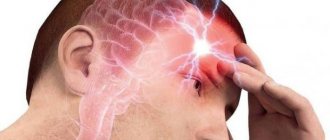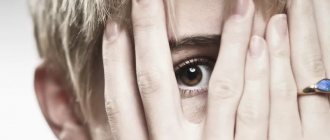Signs of vegetative-vascular dystonia are varied, in most cases they are a consequence of neurosis. VSD and neurosis are concomitant disorders; in addition, patients with VSD may experience mental disorders. Complex therapy allows you to eliminate the physiological and mental manifestations of the disease.
Effective treatment of neuroses and mental disorders in VSD is carried out by neurologists, psychotherapists, exercise therapy instructors and other specialists at the Yusupov Hospital, who use sound and safe methods of therapy.
VSD: astheno-neurotic syndrome
Modern experts believe that vegetative-vascular dystonia occurs as a result of stressful influences, as a result of which the functioning of the body’s systems is disrupted. Many people believe that neurosis and VSD are the same thing, but this opinion is erroneous. Various types of neuroses are common disorders that accompany VSD. However, most often when examining patients, astheno-neurotic syndrome is revealed.
When the nervous system is depleted in a person, astheno-neurotic syndrome is formed, the main manifestations of which are:
- emotional instability;
- high fatigue, which occurs even with minimal loads;
- drowsiness;
- feeling of weakness;
- cardiopalmus;
- trembling in the body.
Modern specialists use effective methods to restore normal functioning of the nervous system and neutralize the manifestations of VSD. When patients present with signs of impairment, the attending physician prescribes a comprehensive diagnosis to determine the degree of clinical manifestations and causes of the impairment. Based on the diagnostic results, methods are determined that need to be used as part of complex therapy.
The specialists at the Yusupov Hospital treat every patient with care. The coordinated work of the medical staff and other employees of the Yusupov Hospital is aimed at providing quality services in conditions of increased comfort.
Causes and predisposing factors
The causes of VSD remain the subject of debate. These are due to differences in opinion about what the syndrome itself is. A number of doctors perceive vegetative-vascular dystonia as a consequence of diseases of any organs. The appearance of symptoms of vegetative-vascular dystonia is explained by secondary disturbances in nervous regulation against the background of the existing disease. For example, with cardiac manifestations of VSD, the doctor begins to look for pathology of the heart and blood vessels. Failures in finding the disease are explained by incomplete laboratory and instrumental examination of the patient.
Modern medicine is of the opinion that VSD is caused by excessive overload or disturbances in the psycho-emotional sphere. The variety of symptoms that mimic the pathology of internal organs is actually a manifestation of psychological stress. This is confirmed by laboratory and instrumental data. During the examination of the patient, no abnormalities in the internal organs are revealed.
Autonomic dystonia is part of the group of neurotic disorders (neuroses). This group of conditions is determined by the characteristics of the response to stressful situations. At the same time, in a number of patients, the symptoms of VSD (cardiac, gastrointestinal, respiratory) come to the fore and are accompanied by painful experiences.
The psychogenic nature of vegetative-vascular dystonia is also explained by the variety of mental disorders in patients with this diagnosis. Somatic (organ) manifestations are often combined with anxiety-phobic and obsessive-compulsive disorders, depression. When taking a detailed history, patients are found to have had traumatic situations in the past, signs of social maladaptation, family and interpersonal problems.
In addition to psychoemotional disorders, the following factors play a role in the development of VSD:
- hereditary and constitutional features of the autonomic nervous system;
- unfavorable course of pregnancy, childbirth and the early postpartum period;
- diseases of the central nervous system;
- characteristics of the patient’s character and personality;
- hormonal imbalance;
- excess body weight;
- infectious diseases;
- suffered acute and chronic diseases, as well as surgical interventions.
A special place in the causes of vegetative-vascular dystonia is given to lifestyle disorders. Predisposing factors may include a sedentary lifestyle, disturbances in sleep-wake cycles, bad habits, monotonous work, mental and physical stress.
Derealization in VSD
VSD and mental disorders can manifest themselves against the background of mental trauma, strong experiences and physical and nervous exhaustion. Some patients with VSD develop signs of mental disorders that do not allow them to lead a full life.
The feeling of unreality of what is happening during VSD or derealization is the brain’s reaction to stress. With this disorder, a person perceives the world around him as distant and unreal.
This disorder is different from panic attacks. The main signs of derealization are:
- perception of reality as unreal;
- changes in the perception of sounds, colors;
- feeling of weakness;
- increased blood pressure;
- fear of madness.
Against the background of these symptoms, the patient maintains adequate behavior and controls his actions. If signs of derealization appear, you must immediately consult your doctor who will prescribe treatment.
When treating derealization, it is necessary to get rid of bad habits and optimize time for rest and work. At the Yusupov Hospital, experienced psychotherapists interact with patients who have a feeling of unreality of what is happening with VSD, who use safe methods to eliminate depression and other manifestations of the disorder.
Treatment of vegetative-vascular dystonia
Konstantinov Maxim Viktorovich
Therapist
March 26, 2020
Vegetovascular dystonia (hereinafter referred to as VSD), also known as neurocirculatory dystonia, also known as somatoform autonomic dysfunction of the nervous system, is not an independent diagnosis, but a syndrome, that is, a complex of symptoms that have the same mechanism of occurrence.
How to treat VSD?
The correct answer is no. This is the same as answering the question: “How to treat a runny nose?” It all depends on the cause, the disease and the situation in which it appeared: from allergic rhinitis and deviated nasal septum to acute sinusitis and adenoiditis. Vegetative-vascular dystonia, in fact, is a disorder of the body's regulation. Normally, a person lives in the “awake” and “rest” modes. In an active state, the body must devote all its resources to the brain, heart, lungs and muscles, and during rest it must switch to sleep and digestion. With VSD, this regulation is disrupted: when you need to run, the blood vessels relax instead of constricting, and blood pressure, instead of an adaptive increase, on the contrary, decreases. If the rest and relaxation phase is disrupted, the body does not redirect blood flow to the digestive organs, provokes spasms, the heart continues to receive the command to work actively, and the muscles remain toned. Therefore, considering VSD as a diagnosis and trying to cure it will be ineffective. First of all, we need to establish the cause.
Why is this diagnosis made by doctors?
The fact is that diagnoses can be syndromic at the diagnostic stage: when the situation has not yet been clarified, and when it goes beyond the competence of a specialist. Here we smoothly move on to the question of the reasons for this diagnosis. After all, most often behind the symptoms lie adaptation disorders, chronic stress, anxiety and depressive disorders. Agree, these are not the diagnoses (in their final form) that ordinary doctors work with in clinics.
It is not difficult to suspect these violations. the typical symptoms of VSD :
- Unreasonable heartbeat
- Attacks of pale skin
- Tingling in the heart area
- Blood pressure instability
- Dizziness and headaches
- Feeling short of air
- Abdominal cramps
- Stool disorders
- Excessive sweating
- Darkening in the eyes
The doctor’s task is to exclude all possible somatic diseases (i.e., diseases of specific organs) according to his profile before referring the patient to the right specialist. And such exist in our time. Yes, in our time, VSD is not a death sentence!
Is neurocirculatory dystonia always a pathology?
If we are talking about an actor who got so into the role that he fainted after the performance, no, this is a completely natural reaction to acute stress. If a young man’s vision darkens and he feels a little dizzy against the background of hormonal surges, this is also not a pathology, but a variant of the norm. Fortunately or unfortunately, we have entered the new 21st century (for quite some time now). There is no place for solitude and sedateness. We are immersed in a sea of information and tied to our phones, email and social media. Living online 24/7 does not always have a positive effect on our health. It’s not that this was a pandemic, but the nature of diseases in society has changed its emphasis: if previously people were killed by hard physical labor, now it’s a non-stop lifestyle.
Of course, people don’t die from VSD. But the diseases that lie behind it can seriously disrupt the quality of life. Fortunately, the vast majority of them are treatable and correctable . And there is no need to delay: if chronic stress, anxiety and depression lead you to neurosis, treatment will be more difficult, longer and more expensive. So, if you have symptoms of vegetative-vascular dystonia, and you feel anxiety, depression, chronic fatigue, and inability to relax, then it’s time to get diagnosed and understand your diagnosis, or rather, what caused it. And remember, according to the definition of the World Health Organization, health is a state of complete physical, mental and social well-being , and not just the absence of disease and physical defects. Your health is in your hands, be healthy!
VSD with agoraphobia
Fears and panic attacks during VSD occur suddenly in patients. Agoraphobia is one of the defense mechanisms that manifests itself unconsciously. This condition is characterized by a person’s avoidance of open spaces. Experiences arise as a result of traumatic situations that are associated with surrounding people.
The development of agoraphobia is influenced by bad habits, mental illness, trauma received in childhood, and bad habits. The main symptoms of agoraphobia are:
- shallow breathing;
- cardiopalmus;
- tinnitus;
- skin redness;
- intense sweating;
- fear that people around will notice the attack;
- feeling of embarrassment;
- fear of going crazy;
- fear of death.
Patients come to the Yusupov Hospital who say that they seem to be going crazy from VSD; they have read reviews about this disorder online and thereby independently aggravate their condition. Agoraphobia also causes behavioral symptoms. The patient begins to avoid environments or circumstances that cause fear. He becomes more confident when surrounded by close people, for example, when going to the store with a relative.
Agoraphobia with VSD is treated at the Yusupov Hospital through regular sessions with a psychotherapist and taking medications. For drug treatment, tranquilizers and antidepressants are prescribed. These drugs have side effects, psychotherapists at the Yusupov Hospital select the safest drugs for patients.
Sudden vegetative-vascular attack
The so-called “vegetative-vascular crises”, which in practice occur like panic attacks, deserve special attention. The sudden onset of feelings of fear and anxiety is accompanied by severe somatic symptoms (palpitations, inability to breathe). They are extremely difficult for patients to tolerate and lead to complete social maladjustment. Moreover, a person is constantly in painful anticipation of a second attack.
In some patients, the attack appears suddenly. Others note a clear relationship with potentially threatening or stressful situations. This could be being in society, a cramped room or space, exciting news, etc.
In addition to severe anxiety and fear, the patient experiences palpitations, a lump in the throat, a feeling of lack of air and the inability to breathe. Choking, dizziness, increased heart rate, as well as disorientation in space and time lead to a feeling of fear of death. A panic attack often causes an ambulance to be called.
Does psychotherapy help with VSD?
A psychotherapist for VSD affects the psycho-emotional sphere using various methods. In most cases, after treatment for neuroses and psychological disorders associated with VSD, complete recovery occurs. During sessions, psychotherapists teach techniques to curb the manifestation of derealization and agoraphobia.
Psychotherapists use structured techniques to help relieve the patient from the manifestation of these disorders. During sessions, the patient can trust the specialist and talk about his experiences. If you need advice from a psychotherapist or other clinic specialists on the treatment and diagnosis of VSD and its manifestations, make an appointment by calling the Yusupov Hospital.
How does neurosis manifest itself?
Neurosis can manifest itself in completely different ways and on different fronts. Among the mental manifestations that are usually difficult to hide: anxiety, asthenia or a feeling of powerlessness, depression, phobias, hypochondria (the belief in the presence of a serious illness), obsessive states. The heart may be shaky and breathing may be impaired. Neurosis may be accompanied by stomach problems, pain in various parts of the spine, chills, or, conversely, an increase in temperature. Sleep disturbances and problems in the intimate sphere are frequent companions of neurosis.
Types of neurotic disorder
All neuroses go through 3 stages . The first of them lasts 1 month and is characterized by acute mental trauma. If its consequences were not noticed in time, then the process develops, certain reactions appear and awareness of one’s “abnormal” state occurs. When the disorder lasts from six months to 2 years, they speak of its second stage.
If the disease is not eradicated in the first two stages, it becomes a chronic disorder with persistent changes in the personality structure.
There are three most common types of neurosis : neurasthenia, obsessive-compulsive neurosis and hysteria.
The main symptoms of neurasthenia are exhaustion and increased fatigue against a background of irritability and hyperexcitability. Other symptoms may also occur: increased sensitivity to bright light, temperature changes, loud conversations. Autonomic disorders also appear: tachycardia, increased sweating, headaches. It is difficult for the patient to concentrate and tune in to any activity.
Hysteria is a type of neurosis that is nicknamed the great malingerer for the variety of its symptoms. The hysterical type of character contributes to its development.
Among the manifestations of the disease are attacks of suffocation, sobbing or laughter. It can masquerade as a hypertensive or cardiac crisis. There is temporary immobility and loss of sensation in the limbs. Neurotic deafness and blindness rarely occur.
Probably the most well-known symptom of the disorder is an attack of hysteria. With it, a person faints, but, surprisingly, very successfully. Convulsive-like seizures may occur. Patients wave their arms, “killed” by suffering, their body bends into an arc. Such an attack is demonstrative in nature. Women are more often susceptible to them.
Despite the depressing, painful symptoms, patients do not strive to get rid of this condition. On the contrary, they skillfully manipulate it. Whenever there are any complaints against them, they refer to their “serious” illness. As a rule, such individuals are demonstrative and self-centered.
Be careful: hysteria can be contagious! This was proven by a case in one of the schools in Tanganyika. The three girls laughed so contagiously that their laughter was echoed by 95 students. The maximum duration of the attack was 16 days. This school was closed, but 14 more schools took up the baton. In total, about a thousand students suffered a hysterical attack. Poor living conditions of the hostel in which they lived and the inability to make a claim are considered a possible cause of hysteria among the girls.
Obsessive-compulsive neurosis is another form of the disease in which certain thoughts, actions, and fears become so intrusive that a person perceives them as painful, they interfere with his usual way of life.
Among the most common phobias are fear of death, fatal disease, heights, confined spaces, and others.
Fears can also provoke obsessive actions. Thus, individuals strive to constantly wash their hands so as not to “catch any infection”, disinfect everything around them, and avoid public places.
Compulsions can also occur on their own. For example, there is an uncontrollable desire to swear or do something illegal.
The famous inventor Nikola Tesla suffered from obsessive-compulsive disorder. His mania reached the point where he could count steps, cups of coffee or pieces of food. He was terrified of germs, which is why in a hotel he demanded that towels be changed up to 18 times a day, and in a restaurant, if a fly landed on the table, he demanded that it be reserved. The hotel room had to be a multiple of three.










